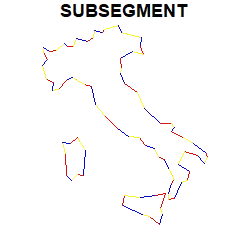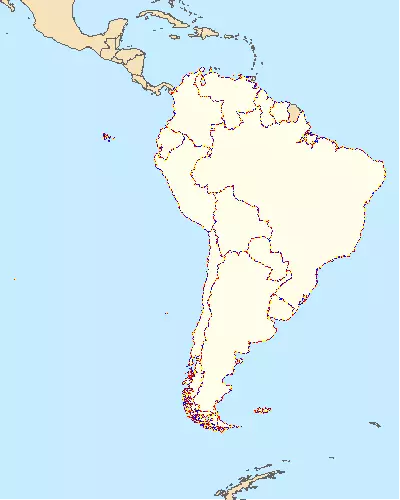This post introduces a used-defined function used for casting sf objects of class LINESTRING or POLYGON into sub-strings.
Required R packages
library(sf)
library(rnaturalearth)
library(dplyr)
The problem
The sfpackage includes st_cast, a very powerful function that transforms geometries into other different types of geometries (i.e. LINESTRINGto POLYGON, etc.).
italy <- ne_countries(country = "italy", returnclass = "sf")
italy_pol <- italy %>% st_cast("POLYGON")
italy_lin <- italy_pol %>% st_cast("LINESTRING")
italy_pt <- italy_lin %>% st_cast("POINT")
par(mfrow = c(2, 2), mar = c(1, 1, 1, 1), bg = NA)
plot(st_geometry(italy), col = c("red", "yellow", "blue"), main = "MULTIPOLYGON")
plot(st_geometry(italy_pol), col = c("red", "yellow", "blue"), main = "POLYGON")
plot(st_geometry(italy_lin), col = c("red", "yellow", "blue"), main = "LINE")
plot(st_geometry(italy_pt), col = c("red", "yellow", "blue"), main = "POINT")

What I missed when using st_cast is the possibility to “break” the LINESTRING objects into sub-segments:

An approach
So one possible solution could be to create LINESTRING objects for each consecutive pair of POINT objects across the original geometry. Let’s check it:
par(mfrow = c(1, 2), mar = c(1, 1, 1, 1))
test <- ne_countries(country = "spain", returnclass = "sf") %>%
st_cast("POLYGON") %>%
st_cast("LINESTRING")
plot(st_geometry(test), col = c("red", "yellow", "blue"), main = "LINESTRING")
geom <- lapply(
1:(length(st_coordinates(test)[, 1]) - 1),
function(i) {
rbind(
as.numeric(st_coordinates(test)[i, 1:2]),
as.numeric(st_coordinates(test)[i + 1, 1:2])
)
}
) %>%
st_multilinestring() %>%
st_sfc(crs = st_crs(test)) %>%
st_cast("LINESTRING")
plot(st_geometry(geom), col = c("red", "yellow", "blue"), main = "AFTER FUNCTION")

The function stdh_cast_substring
Finally, I wrapped the solution into a function and extended it a little bit:
-
When the input is not a
LINESTRINGor aPOLYGONreturns an error and stops. -
The function accepts
sfwith several rows orsfcobjects with several geometries, and returns the same class of input. In the case ofsfobjects, the inputdata.frameis added. -
By default, the output is a
MULTILINESTRINGgeometry. This has the benefit that output has the same number of geometries than the input. This can be modified setting the parametertoasLINESTRING, that in fact only casts theMULTILINESTRINGobject intoLINESTRING.
stdh_cast_substring <- function(x, to = "MULTILINESTRING") {
ggg <- st_geometry(x)
if (!unique(st_geometry_type(ggg)) %in% c("POLYGON", "LINESTRING")) {
stop("Input should be LINESTRING or POLYGON")
}
for (k in 1:length(st_geometry(ggg))) {
sub <- ggg[k]
geom <- lapply(
1:(length(st_coordinates(sub)[, 1]) - 1),
function(i) {
rbind(
as.numeric(st_coordinates(sub)[i, 1:2]),
as.numeric(st_coordinates(sub)[i + 1, 1:2])
)
}
) %>%
st_multilinestring() %>%
st_sfc()
if (k == 1) {
endgeom <- geom
}
else {
endgeom <- rbind(endgeom, geom)
}
}
endgeom <- endgeom %>% st_sfc(crs = st_crs(x))
if (class(x)[1] == "sf") {
endgeom <- st_set_geometry(x, endgeom)
}
if (to == "LINESTRING") {
endgeom <- endgeom %>% st_cast("LINESTRING")
}
return(endgeom)
}
The function could be improved in terms of performance. Given that it works at a coordinate level, for high-resolution objects it has some degree of delay
test100 <- ne_countries(
continent = "south america",
returnclass = "sf"
) %>%
st_cast("POLYGON")
test50 <- ne_countries(50,
continent = "south america",
returnclass = "sf"
) %>%
st_cast("POLYGON")
init <- Sys.time()
t1 <- stdh_cast_substring(test100, "LINESTRING")
end <- Sys.time()
kable(end - init, format = "markdown")
| x |
|---|
| 0.1729319 secs |
init <- Sys.time()
t2 <- stdh_cast_substring(test50, "LINESTRING")
end <- Sys.time()
kable(end - init, format = "markdown")
| x |
|---|
| 2.288558 secs |
par(mfrow = c(1, 1), mar = c(0, 0, 0, 0))
plot(st_geometry(test50), col = NA, bg = "#C6ECFF")
plot(st_geometry(ne_countries(50, returnclass = "sf")), col = "#F6E1B9", border = "#646464", add = T)
plot(st_geometry(test50), col = "#FEFEE9", border = "#646464", add = T)
plot(st_geometry(t2), col = c("red", "yellow", "blue"), add = T, lwd = 0.5)

It can be seen a difference in terms of performance, noting that test100 has 15 polygons decomposed in 914 sub-strings while test50 has 80 polygons to 8,414 sub-strings. In that sense, the original st_cast is much faster, although this solution may work well in most cases.